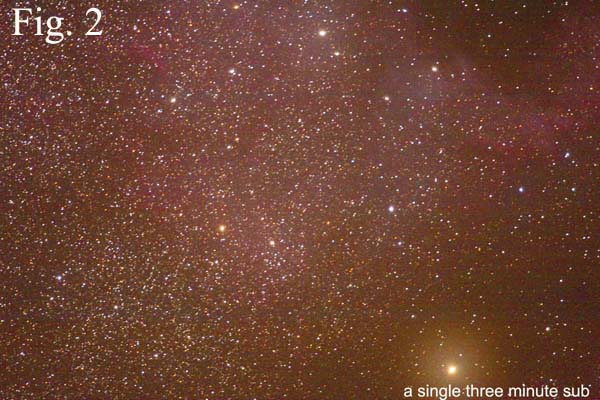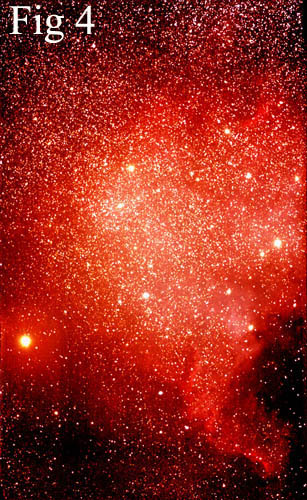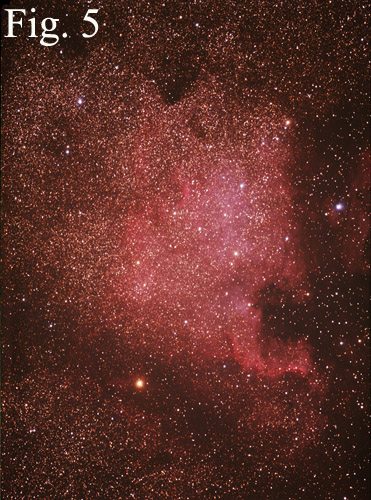The human eye is very insensitive to the red light of hydrogen alpha, thus this gaseous glow is quite invisible to naked eye observers looking toward this section of the Milky Way. In fact, it is very difficult to discern even in fair sized amateur telescopes. It takes special techniques to make the gas clouds appear in their glory. To do so, astrophotographers take numerous, short exposures and "stack" them into a single image. Then computer software is used to enhance the portion of the spectrum that contains the signal from recombining hydrogen atoms. That is what this page is about . . . bringing the North America Nebula out of its obscurity and into plain view.
Not only is the human eye quite insensitive to the light of hydrogen alpha emission, digital camera sensors are actually constructed with special filters that block 90% or more of these emissions. It is not that the camera makers have anything against hydrogen alpha light. The filters are required to block infrared wavelengths that would cause images taken by the camera sensors to appear very unnatural in regard to colour balance. The wavelength of hydrogen alpha is an "innocent victim" if you will of this requirement. Dedicated astrophotographers use cameras that have these filters removed, allowing nearly all of the red hydrogen alpha light to be recorded. My attempts to image the nebula started with an unmodified camera. Results with a modified camera will follow.
So, this page is a journey of sorts. A journey of a neophyte astrophotographer's very first attempt in digital image stacking with a brand new equatorial telescope mount. The journey begins with the very uninteresting image immediately below.

Figure 1 is the raw, unprocessed stack of 30 three minute individual sub exposures from Deep Sky Stacker, a freeware programme available on the internet. My first reaction upon viewing this stack was great disappointment. "There's nothing there. I missed the nebula completely!" "And where are all the stars?" But, wait . . .

Figure 2 shows the result from much jiggery-pokery in Photoshop with a single 3 minute sub exposure from the stack taken at ISO 400. It appears noisy and unsaturated despite absolutely clobbering it in Photoshop. It seems hard to believe it is but a single one of the sub exposures that appear, individually and stacked as well, to be all but blank with just a few stars scattered about.
Figure 3 shows the result from the same amount of jiggery-pokery, more or less, using the full stack of 30 three minute sub exposures at ISO400 along with 5 dark frames in DSS. The dark frames subtract noise generated within the camera sensor itself from the signal being recorded from the nebula across the light years. Figure 3 is much smoother! Amazing that all this detail was hidden in the nearly blank image of the stack shown in Figure 1. There is still a way to go before we get a really nice image of this object though.
Next time I will try a camera especially modified to capture more of the light of hydrogen alpha.. All in all though, from initial utter disappointment, I am quite pleased with what I got on my very first attempts. The journey will continue as these images can still be drastically improved with better equipment and more skill. Shortly after taking these first images, I obtained a modified DSLR camera much more suitable for imaging nebulae of this type. The best image of The North America Nebula I managed with that camera is posted here. Use "Back" button or Return to Home 
 Figures 4 and 5 are about as well as I can do with this first trial I think. The nebula is rotated to better show the North American shape and Figure 5 is taken with a 300mm telephoto lens to better frame it.
Figures 4 and 5 are about as well as I can do with this first trial I think. The nebula is rotated to better show the North American shape and Figure 5 is taken with a 300mm telephoto lens to better frame it. Figure 5 results from stacking 30 three-minute exposures and 20 one-minute exposures using the Canon 300mm/f2.8 lens. Exposures were all at f2.8 and ISO 400 on an unmodified Canon 40D DSLR. The fact that it looks much more subdued than the other images is attributable to more subtle processing in Photoshop. It looks more natural to my eye but, in truth, there is nothing "natural" about any of these images in that viewing hydrogen alpha emission demands filtration and special processing techniques because of the limitations of human vision. The night sky just does NOT look like this to the eye, not even through large telescopes. Only photography can bring out these details.
Figure 5 results from stacking 30 three-minute exposures and 20 one-minute exposures using the Canon 300mm/f2.8 lens. Exposures were all at f2.8 and ISO 400 on an unmodified Canon 40D DSLR. The fact that it looks much more subdued than the other images is attributable to more subtle processing in Photoshop. It looks more natural to my eye but, in truth, there is nothing "natural" about any of these images in that viewing hydrogen alpha emission demands filtration and special processing techniques because of the limitations of human vision. The night sky just does NOT look like this to the eye, not even through large telescopes. Only photography can bring out these details.